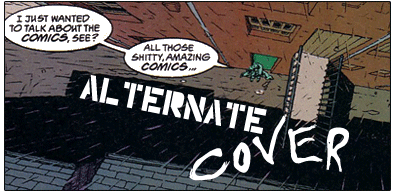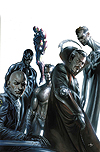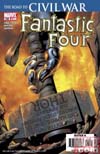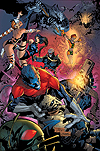Alternate Cover - 2nd April 2006

This week Marvel's Civil War event finally starts coming to the boil after a few months of steady simmering, and both Fantastic Four #536 and New Avengers: Illuminati add their own particular flavour to the mix creating a hearty casserole with a fruity flavour and plenty of notional promise. To wash it down, I'm afraid there's only Uncanny X-Men #471, but then what better way to get the sour taste out of your mouth than with the rich thick layers of The Sentry #7 topped with Ultimate Spider-Man #92's sweet, sweet honey? I think you'll find it all to your satisfaction
Of course, having actually read the comics, I'm starting to wonder if maybe I should have just got a takeaway instead.
(That, kids, is an extended metaphor. Some might say extended to the point of incomprehensibility. Those people are simply not trying hard enough.)
My pick of best comic for this week, in lieu of anything by Brian Wood, is All Star Superman #3, which I haven't reviewed, but which is far better than anything in this column. If you really want to buy a Marvel issue, go with the Illuminati special, to which I deliver the dubious credit of "best of a bad bunch." Enjoy!
 |
New Avengers: Illuminati
Publisher Marvel • Writer Brian Michael Bendis • Artist Alex Maleev
While the Illuminati special has been billed the issue that kicks off the whole civil war event, it's easy to see that we're well into it already, which leaves this issue something of an anomaly. For a start, it's billed as a "New Avengers" comic even though Iron Man's the only current Avenger who shows up. That's what we call a "marketing ploy." Secondly, since it's trying to insert a fairly major concept into Marvel history, it reads as very little more than a bunch of continuity restructuring scenes, with a lot of expositionary dialogue. It's not really kicking off Civil War, it's just trying to explain why certain characters might be acting as they are.
That's not to say it's bad, though, it just feels as if you can get the same kind of story from flashbacks in other issues which have already shown us the concept of the Marvel heroes "Illuminati" and the sort of thing they do. It's all Iron Man's idea, it seems, and the issue focuses heavily on him. This makes it quite confusing when his position turns out to be the direct opposite of what we just saw in a recent Spider-Man issue, where he was arguing against the super-human registration bill. It's not an irresolvable conflict of behaviour, but it does create a gap that needs filling when this issue spends the rest of its time filling other gaps.
Probably the most enjoyable character in the issue is Namor, who is in full-on 70s psychopath mode, shouting about how the business of the surface-world doesn't matter to him and then trying to drown Tony. Which, frankly, I can relate to given the events of the rest of the issue. The art by Maleev is as excellent as always, if slightly inappropriate for the characters, and while the story itself isn't up to much, Bendis' dialogue is a sharp as ever (Thought the mind boggles to consider what he was thinking in a scene where Tony refers to recent events by their published titles). It's by no means a bad comic, it's just that for something that's been billed so highly, you expect a little more from it than a set of largely peripheral retcons and statements of intent. The preview of Civil War at the end of the book has me far more excited. B+
 |
Fantastic Four #536
Publisher Marvel • Writer J. Michael Straczynski • Artist Mike McKone
Following last issue's surprisingly stealthy use of Civil War-related content, this one comes right out and makes sure you know about it, even going so far as to include a page from the Illuminati special. Before we get too far in, though, the plot is interrupted by the news that Doombots are attacking the site where Thor's hammer fell back to Earth, and the F4 scramble to see what the deal is. They don't know it's Thor's hammer (and technically neither do we - it's just that it's taking up 80% of the cover and the story is called "The Hammer Falls" so I'm going to go out on a limb and say it) just that the doombots are after something - by the time they figure out what there's already been an explosion that's destroyed the whole site. And then Dr. Doom comes back from the dead just long enough to be there when Reed finds out what's going on.
What? Sorry? Ah yes, you may have noticed that. Dr. Doom, who was last seen trapped in Hell, is back, and he's using his army of robots to try and steal Thor's hammer. This isn't exactly crafty planning - he's kind of lost the element of surprise by letting his enemies know that he's back from the dead. Early reports indicate that he may have escaped Hell by hitching a ride of Mjolnir (the hammer in question) as it flew through various dimensions following the destruction of Asgard, but given the scale of the character, it's a little jarring for his return to amount to little more than him walking up behind Reed to stare into the edge of a crater and go "Ah, brilliant, that's what I was after."
In recent issues Straczynski has done a good job of setting up the tension between Reed and Sue that's going to cause them to fall on opposing sides of the issues at the heart of Civil War. It's a pity that once the opening scene which deals with this tension finishes, the second and third acts then consist of the team fighting Doombots, which is so thematically and visually uninteresting you may as well skip to the end and read the last two pages, even if the cover did spoil the big reveal for you.
Exactly what Doom is planning to do with Thor's hammer is also left as something as a mystery - he claims it's going to give him a lot of power, but traditionally Mjolnir's main power has been to turn its bearer into the Thunder God. Since Ragnarok has occurred and there's no Thunder God turn into, we'll have to assume that there's a larger story at work there - or perhaps Mjolnir's power over the weather is likely to bring the UN to its knees. I don't really know, and right now, I'm not sure I even care. C
 |
Uncanny X-Men #471
Publisher Marvel • Writer Chris Claremont • Artist Billy Tan
It's hard to review this issue. Claremont's no longer on borrowed time, he's off the book. Soon Ed Brubaker, who's currently proving he can do the X-Men in the Deadly Genesis mini is taking over the title, and there's a definite sense of relief coming over me. While this issue is one of his more coherent, it still suffers from all the same problems he's had ever since he returned to the core books with the quickly-dispatched-of "X-Men Revolution" reshuffle some years ago.
The story itself could well have been played as the natural successor to Phoenix: Endsong. Having had little success with destroying the Phoenix, the Shi'ar are attempting to end the Grey (as in Jean Grey) bloodline to try and prevent the return of Phoenix. Rachel, as the bloodline's sole survivor following their recent massacre, is the star of the piece and it mainly deals with her attempts to take the moral high ground over the people who killed her family. With that in mind, it seems pretty straightforward, but somehow it doesn't hang together like it should.
The villains are near-complete cyphers with stupid codenames and powers fully explained, but not a hint of nuance. Unfortunately for the bulk of the issue, the X-Men are locked in combat with them, leaving very little of interest in the rest of the issue. A member of Sentinel Squad O*N*E shows up just in time for me to lose interest completely, because despite the frequent pushes the concept is getting in the pages of the X-Men titles, I can't pretend anything about it intrigues me, and every time they show up it seems more and more like an advert for their own title. Billy Tan's art is enjoyable, and while in general fans have been upset with in the past, I've never had any difficulty with it. It's not enough to save the story, though, because even if Tan is accurately conveying what Claremont is going for, it still won't make a lot of sense. C-
 |
The Sentry (Vol. 2) #7
Publisher Marvel • Writer Paul Jenkins • Pencils John Romita Jr. • Inks Mark Morales
A disappointing penultimate issue finds the Sentry under the belief that his life as both Sentry and The Void, as well as the rest of the Marvel universe, are all a delusion, and he's living in a mental institution. My initial inclination of course was "Hey, didn't I see this episode of Buffy?" and then "And that episode of Star Trek: TNG..." by which point you're realising that this storyline is tired. So very tired.
There's absolutely no chance for suspension of disbelief, because in the context of the comic we know that Reed Richards, Bruce Banner, and all those alliteratively-named guys are real. The Sentry has always straddled the boundaries of metafiction, but right now it's sinking into the mire of it as we're asked to deal with yet another potentially true reality for the Sentry.
It's unfortunate that Jenkins went this route. It feels like a lot of filler material just to tread a bit of water until the finale, which admittedly looks like it could be pretty good. It does appear to hinge on just what the big secret of the Sentry is, so I'm quite cautious. The Sentry has unravelled a lot of his past, so finding something that's both suitably significant and unexpected is likely to be a problem. That said, I swear that if the secret of the Sentry is anything to do with reality as being dictated by comicbooks, I'm going to scream. The series until now has been a good read, never quite reaching the heights of the opening issue, but there's been nothing as bad as this until now. Even Romita's art can't save it from mediocrity. C-.
 |
Ultimate Spider-Man #92
Publisher Marvel • Writer Brian Bendis • Pencils Mark Bagley • Inks John Dell & Mark McKenna
I have to admit, Kitty Pryde notwithstanding, I'm not a fan of Ultimate crossovers. I think it dilutes the uniqueness of the reason for the Ultimate universe to have the characters showing up in each other's books. "Dilutes" is certainly the word here, as well, as Spidey has to fight for page time with around 8 X-Men, 5 or so cyborg mercenaries and Ultimate Deadpool.
The reader, on the other hand, finds themselves more or less dropped into the middle of a sequel arc to a recent Ultimate X-Men storyline, though at least I was able to adequately gauge that from the issue itself. The problem is, I don't care about the Ultimate X-Men and I don't care about this reality-TV-meets-murder version of Genosha. I'd rather be reading about Spider-Man in the usual setting, and nothing so far has endeared me to the premise for this arc.
It's certainly a well-executed comic - Bagley's art is wonderful and the high point of removing him from the usual Spider-Man locales is that at least we see a bit of variety from him. The character moments are great, Ultimate Deadpool is suitably unhinged - there's nothing in here that'll make you hate it, it's just that I can't shake the feeling that there are way more stories that need doing with Ultimate Spider-Man and they don't involve the X-Men. I've got a horrible feeling that the Kitty Pryde/Peter Parker relationship only has up until issue 100 and if that's the case I'm going to incredibly upset at the creative team for wasting time with a gratuitous X-Men crossover.
The quality of writing on USM has been highly variable in recent years, after an incredibly strong start. Bendis and Bagley are going for a record run on the title, but especially when arcs like this come along, it's easy to wonder if it's harming the title. Sister title, Ultimate X-Men, is seemingly going from strength to strength with a rotating creative team - not without weak spots, to be fair, but certainly with greater critical attention that yet another USM issue is likely to get. This is one of Marvel's flagship titles and it should probably be concentrating on telling Spider-Man stories rather than X-Men ones. That said, it's great to see Bagley drawing the X-Men, in any incarnation - but that's the high point of the issue. C+
About this entry
- By James Hunt
- Posted on Monday, April 03 2006 @ 12:02 am
- Categorised in Comics
- 0 comments
